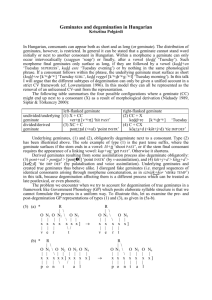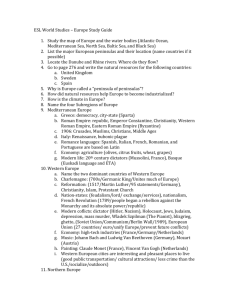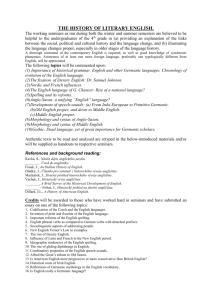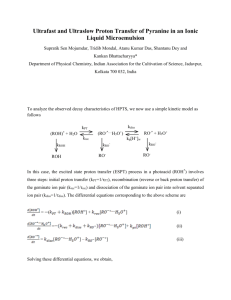Perceptual and articulatory notes on the origin of Germanic geminates Sverre Johnsen
advertisement
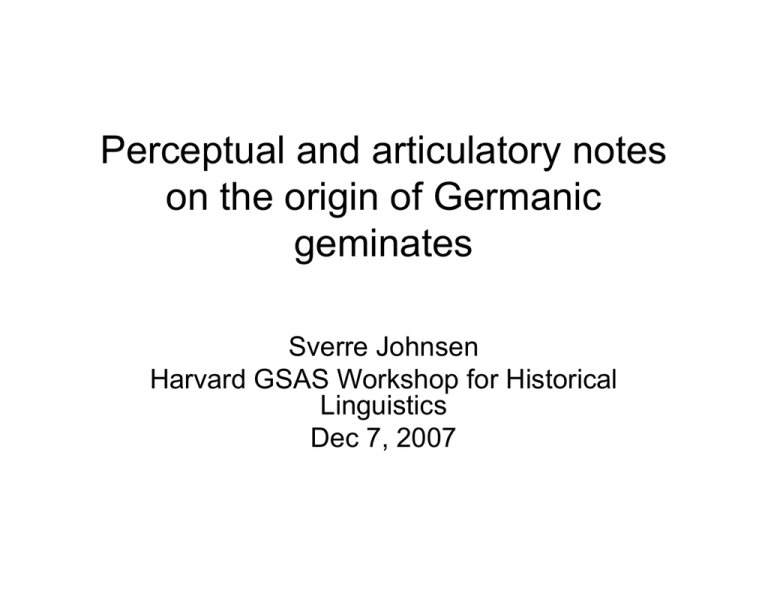
Perceptual and articulatory notes on the origin of Germanic geminates Sverre Johnsen Harvard GSAS Workshop for Historical Linguistics Dec 7, 2007 New solutions to old ‘problems’ • We’ll have a look at two geminate issues in historical Germanic grammar today: 1) The occlusivization of geminate glides to geminate stops in North and East Germanic 2) The identical behavior of *NT (nasal+stop) and *hT in Nordic – they both become TT Occlusivization of geminate glides • A small set of words in the three Germanic branches has the following properties: • In North and East Germanic, they exhibit a geminate stop with an offglide • In West Germanic, they exhibit a diphthong plus a glide • Gothic (East Germanic) • twaddjē ‘two’ (gen.pl.) • triggw- ‘true’ • Old Norse (North Germanic) • tveggja • tryggv- • Old High German (West Germanic) • zweiio • triuwi • We have the following correspondence between North-East Germanic and West Germanic: • North-East G. West G. • -ddj-jj• -ggw-ww- A couple of words on the correspondence 1) • Why do I list the West Germanic forms as having -jj- and -ww-, and not -ij- and -uw-, with the final part of a diphthong + glide? • One of the two segments in a diphthong must be a glide • If not, what is the difference between a rising diphthong [ju], a falling diphthong [iw] and a hiatus sequence [iu]? • We know that the Germanic diphthongs ending in /u/ and /i/ were falling diphthongs, i.e. ending in [w] and [j] • Consequently, the West Germanic sequences /Vij/ and /Vuw/ are to be analyzed as /Vjj/ and /Vww/ 2) • Why aren’t I making a point out of the fact that within North-East Germanic, there is disagreement in the reflexes? Namely: • Old Norse has -ggj- where Gothic has ddj• The difference is trivial • First, they might represent the same phonetics, [j] (Icelandic and many Nordic dialects still represent /ggj/ as []) • Second, a change from a laminal palatal [] to a dorsal palatal [g] (and the other way around) is straight-forward, given that the [] presumably only existed in this small set of words • So, what we need to explain is the following correspondence: • North-East G. West G. • -ddj-jj• -ggw-ww- Origin • The small set of words with this behavior in Germanic does not correspond to words in other IE languages with obstruents • Rather, the non-Germanic cognates show a diphthong ending in a glide /j/ or /w/ • Consequently, the North-East Germanic forms with /ddj/ and /ggj/ are secondary developments • The West Germanic forms with /Vjj/ and /Vww/ represent therefore the original state in Germanic • Most of the research on these clusters in Germanic has focused on how the geminate glides arose in Germanic • I will focus on the development of geminate glides to geminate stops in North-East Germanic Perception of geminate glides • Kawahara (2005) shows through perceptual experiments that listeners have difficulties distinguishing geminate glides from geminate singletons • Following Kawahara, the reason for this goes as follows: • The by far most important perceptual correlate of a distinction between a geminate and a singleton is that the constriction duration is accurately heard • Glides are at disadvantage for the distinction between geminates and singletons because the acoustic transitions between the surrounding vowels and the glide are blurry • This because glides have vowel-like qualities • As a result, it’s harder to perceive when the constriction begins and ends • Second, glides typically have ‘stretched cues’ – palatality and labiality • These tend to extend over a domain larger than the adjacent segments • The cues for the glides can therefore be perceived before the actual constriction starts, and after the constriction ends • The fact that it is difficult to perceive the difference in constriction duration between geminate and singleton glides can explain why geminate glides disappeared from North-East Germanic • But we would expect degemination, not occlusivization • A geminate glide can hardly by itself be misperceived as a geminate stop + offglide, since that would entail that vowel-like cues are misperceived as cues for a stop Articulation of geminate glides • Podesva (2002) argues that geminate fricatives require greater articulatory precision than stops • This because the upward movement of the tongue in a geminate fricative risks being overshot, or ‘realized too fully’ • The same risk does naturally not occur in a stop • I wish to apply the same reasoning to geminate glides • Glides are quite similar to fricatives, the main distinction being that glides are articulated with less constriction • It is articulatory difficult to maintain the correct constriction degree over time, sometimes leading to a less effortful overshooting, resulting in a place-identical stop Two forces working together • • By experiencing misperceptions (either himself or in others) and corrections, the speaker ‘knows’ that a geminate glide is easily confused with a singleton glide Speakers will try to produce and pronounce the glides with clearer transitional cues in order to distinguish them more clearly from the surrounding vowels • The speaker has two choices to make the geminate glide distinctive: 1) Slightly extend the duration 2) Slightly clarify the constriction • Extending the duration will, unless made extreme, hardly remove the ambiguity • A longer duration does not fix the ‘problem’, namely the non-unique cues before, during and after the constriction • As argued by Kawahara, the most important cue is the correct perception of the constriction duration • If the constriction is made clearer, then the cues for the constriction will be more distinct from the neighboring vowels • A clarification greatly increases the risk of overshooting the articulation and producing a stop Tying up • Geminate glides are hard to distinguish from singleton glides because it’s hard to perceive when the actual constriction occurs • To fix this problem, speakers try to make the constriction clearer • The cost is overshooting the articulation, and thus occlusivize the glide • Proto-Germanic *-jj-, *-ww- > North-East Germanic -j-, -ggw- is a historical representation of this development • Finally, the same explanation should be extended to other languages, such as LuGanda, where a synchronic gemination process takes [j] to [] and [w] to [ggw] • [w] → [ggw] is also a synchronic process in Berber References Kawahara, Shigeto (2005). Sonorancy and geminacy. ROA 775. Podesva, Robert (2002). Segmental constraints on geminates and their implications for typology. LSA handout 2002. Nordic rhinoglottophilia • Early Nordic underwent several assimilation processes that resulted in geminate stops • Most notably, the frequent sequence *ht assimilated to tt • And a nasal followed by a voiceless stop gave a geminate stop: • *mp > pp, *nt > tt, *nk > kk • The idea proposed here is that the sequence *NT underwent ‘rhinoglottophilia’ and became *hT before the ultimate assimilation to TT • The primary reason for this proposal comes from preaspiration Preaspiration in Nordic • The facts of preaspiration in Nordic here are taken from Helgason 2002 • Preaspiration is generally considered as ‘extremely rare’, downplayed by Helgason to ‘relatively rare’ • In Europe, preaspiration is confined to a geographical area: • Scandinavia, Iceland, the Faroese islands, the Western Isles, Northern Scotland Saami West Nordic Gaelic East Nordic • The preaspiration is shared among three language families: Germanic, Celtic, and Finno-Ugric • The preaspiration in Finno-Ugric and Celtic is only found in languages under heavy influence from (West) Nordic • The preaspiration in these languages is therefore considered a superstrate phenomenon • Blevins/Garrett 1993 cite the Northern European state of affairs as the only example of preaspiration of original geminates • Given the rarity of preaspiration, it needs to be explained where it occurs, and not as a natural spontaneous intrusion Preaspiration in Nordic: Iceland • Thráinsson 1978 provides an elaborate explanation of preaspiration in Icelandic, within a rule based approach • If we focus on the surface realization, however, the facts are surprisingly straight forward • A voiceless stop after a short vowel surfaces with preaspiration Icelandic • • • • • • [khahp], [hahtr], [ahka], [hpl], [hpna] [saith] f.adj. + /-t/ → [saiht] n.adj. [ljowth] f.adj. + /-t/ → [ljowht] n.adj. [nitha] inf. + /-ti/ → [nihti] pret. [vœkva] vs. [sœhkva] [lithl] f.sg.adj. + /-ar/ → [lhtlar] f.pl.adj. Faroese • Faroese (Tórshavn dialect) matches Icelandic • Voiceless stops after a short vowel become preaspirated • Especially interesting is the comparison between Icelandic and Faroese for words with a sequence /p,t,k/ + /l,r/ • In Icelandic, the preceding vowel is short, so the consonant becomes preaspirated • In Faroese, however, the preceding vowel is long, hence no preaspiration • epli ‘apple’: Icl. [hpl], Far. [plə] • betri ‘better’: Icl. [phtr], Far. [pet] • In Icelandic and Faroese, then, the use of preaspiration is conditioned by synchronic surface constraints • The historical origin plays no longer any role Norwegian • The most interesting dialects in Norwegian when it comes to preaspiration are the dialects of Gudbrandsdalen and Härjedalen Gudbrandsdalen Härjedalen Gudbrandsdalen • In this dialect, the distribution is clearly different: • [let] ‘color’, [let] ‘let’ (pret.), [leht] ‘light’ • [nykə] ‘keys’, [hkla] ‘ankle’ • [krə] ‘fields’, [kre] ‘field’, [vahkrastə] ‘most beautiful’, [døhkrə] ‘your’ • The dialect of Gudbrandsdalen is unique in that it maintains the ON distinction of light and heavy syllables • Most other Nordic dialects, including Icelandic and Faroese, have only heavy syllables Light [let] Heavy [let] [let] • The distribution in Gudbrandsdalen matches the Old Norse origin • [let] ‘color’ < ON lit • [let] ‘let’ < ON lét • [leht] ‘light’ < ON létt • [nykə] ‘keys’ < ON nyklar • [hkla] ‘ankle’ < ON okkla • [krə] ‘fields’ < ON akrar • [kre] ‘field’ < ON akri • [vahkrastə] ‘most beautiful’ < Low German wakker + superlative -aste • [døhkrə] ‘your’ < ON þykkar • Original geminate /kk/ and /tt/ give [hk] and [ht] in Gudbrandsdalen, whereas original singleton /k/ and /t/ give non-aspirated /k/ and /t/ Härjedalen • The dialect of Härjedalen is similar to Gudbrandsdalen • Original geminate stops give preaspirated geminate stops: • ON sleppa > [slhpe] ‘release’ • ON nátt > [naht] ‘night’ • ON bekk > [bhk] ‘bank’ • Härjedalen has, as most Nordic dialects, no short syllables • Original VC(V) becomes VC(V) • So what happens when the C is /k,t,p/? • It becomes geminated, but not preaspirated • ON skot > [skœt] ‘shot’ • ON lok > [lœk] ‘lid’ • ON dropa > [dropo] ‘drop’ • The distribution of preaspiration does not follow synchronically, since only original geminates are preaspirated Swedish • There are numerous reports from a variety of dialects of preaspiration • The most thorough linguistic description is of the Kökar dialect in Åland Åland Kökar • The Kökar dialect agrees with Gudbrandsdalen and Härjedalen in that original geminates are preaspirated • ON loppa > [lohpa] ‘paw’ • ON nátt > [naht] ‘night’ • ON bekkir > [bæhka] ‘creeks’ • In the cases where the transfer of light to heavy syllables gave a geminate stop, the stop is not preaspirated • ON viku > [vik] ‘week’ • ON dropa > [dropo] ‘drop’ • ON gatu > [gæt] ‘street’ • ON netit > [næt] ‘the net’ Conclusion • Although Icelandic gets most of the attention for preaspiration, the Norwegian and Swedish dialects are more revealing for its origin • Given the existence of both preaspirated and non-preaspirated geminates in these dialects, it follows that the original geminates were preaspirated before new geminates arose • The claim is that all and only the Old Norse geminates /pp/, /tt/ and /kk/ were preaspirated • A common origin of ON /tt/ is a sequence *ht • ON sótt < *suhti- ‘sickness’ • ON nátt < *naht- ‘night’ • ON rétt < *rehta- ‘right’ • That the preaspiration in [ht] is somehow a reflex of the original *h is a readily available hypothesis • The chief origin of ON /pp/, /kk/ and the remaining /tt/, though, is *Np, *Nk, *Nt • It was suggested already in Marstrander 1932 that the sequence with a nasal plus a voiceless stop gave *hp, *hk and *ht, and thus the preaspiration Rhinoglottophilia • The phenomenon of ‘rhinoglottophilia’ refers to the attested fact of misperception and confusion between nasalization and aspiration (or other laryngeal features) • Although they are articulatory quite distinct, their acoustic properties are relatively similar • The discussed cases of rhinoglottophila involve a change from aspiration to nasalization • Any case of misperception should in theory be bidirectional • A striking parallel between Marstrander’s proposed development *NT > *hT is found in Algonquian, as pointed out by Page 1997 • In Cree and Menominee, the ProtoAlgonquian sequences *mp, *nt and *nk collapse with the outcome of *hp, *ht and *hk, in that they all come out as hp, ht and hk • The Cree/Menominee state seems to illustrate the missing intermediate stage in the transition from Proto-Norse to ON Dissident • This idea is found ‘untenable’ in Helgason 2002 for three reasons: 1. The Kökar dialect retains the sequence NT as such, but still has preaspiration 2. If only original geminates were preaspirated, then one Faroese dialect with preaspiration before all voiceless stops except when following a long high vowel cannot be explained 3. Similarly, a Swedish dialect in Gräsö (an island north-east of Åland) has preaspiration of all voiceless stops, regardless of the origin • Claim 1) is wrong • Kökar has, as Swedish in general, many examples of *NT > TT (Karsten 1892, Noreen 1904), although it’s not so widespread as in Old Norse • For claim 2) and 3), it’s hard to see how a complete, or near-complete, generalization of preaspiration disproves an older distribution depending on geminacy • Without assuming rhinoglottophilia, it’s especially hard to see how one can explain the situation in Gudbrandsdalen, Härjedalen and Kökar, where the distribution shows that original geminates are preaspirated, whereas new geminates are not Sum-up • Preaspiration of voiceless stops is crosslinguistically (very?) rare, but frequent in the Nordic region • Some Nordic languages have a synchronic distribution of preaspiration, namely Icelandic and Faroese • Other Scandinavian dialects show preaspiration only when the stop was an original geminate • The ON voiceless geminate stops were thus preaspirated • The preaspiration in /ht/, /hp/, /hk/ is a direct reflex of an original sequence *ht, *hp, *hk • Whereas *ht often came from an original *ht, many others, and all cases of *hp and *hk, come from a sequence *NT • The nasalization changed into aspiration through ‘rhinoglottophilia’, according to which these two properties are easily confused with each other • Some Algonquian languages show precisely the change of *nt, *mp, *nk to ht, hp, ht as we posit for Proto-Norse References • Blevins/Garrett (1993). The evolution of Ponapeic nasal substitution. Oceanic linguistics 32/2. • Helgason, Pétur (2002). Preaspiration in the Nordic languages. PhD dissertation, Stockholm • Karsten, Anton (1892). Kökarmålets ljud- ock formlära. • Marstrander, Carl (1932). Okklusiver og substrater. Norsk tidsskrift for sprogvidenskap 5. • Noreen, Adolf (1904). Altschwedische Grammatik. • Page, Richard (1997). On the origin of preaspiration in Scandinavian. American journal of Germanic linguistics and literatures 9. • Thráinsson, Höskuldur (1978). On the phonology of Icelandic preaspiration. Nordic journal of linguistics 1.

